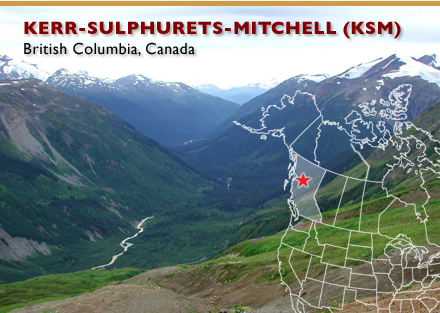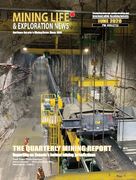Environment Minister Leona Aglukkaq Gives Thumbs Up to Seabridge Gold Mine
 Leona Aglukkaq, Canada's Minister of the Environment, approved the proposed KSM (Kerr-Sulphurets-Mitchell) Gold and Coppe Mine Project located in northwestern British Columbia near the Alaskan border on the grounds that it, is not likely to cause significant adverse environmental effects when the mitigation measures described in the company's comprehensive study report are taken into account.
Leona Aglukkaq, Canada's Minister of the Environment, approved the proposed KSM (Kerr-Sulphurets-Mitchell) Gold and Coppe Mine Project located in northwestern British Columbia near the Alaskan border on the grounds that it, is not likely to cause significant adverse environmental effects when the mitigation measures described in the company's comprehensive study report are taken into account.
The KSM project has been referred back to the responsible authorities, Environment Canada, Fisheries and Oceans Canada and Natural Resources Canada, for appropriate action.
The Minister has also issued a Project Recommendation under the Nisga'a Final Agreement (NFA) that includes provisions to mitigate adverse environmental effects on the Nisga'a Nation.
In reaching her decision and making her recommendation, the Minister considered the comprehensive study report and the comments received from the public, the Nisga'a Nation and other Aboriginal groups on the report.
This project was assessed using a science-based approach in accordance with the Canadian Environmental Assessment Act. The Project was also subject to requirements under the NFA, a modern treaty signed by the governments of Canada, British Columbia and the Nisga'a Nation.
Seabridge Gold Incorporated proposes to develop a combined open-pit and underground gold copper silver and molydenum mine in the Kerr, Sulphurets, and Mitchell Creek watersheds located approximately 65 kilometres northwest of Stewart, British Columbia. The proposed KSM Project is expected to process 130,000 tonnes per day of ore over an anticipated mine life of 52 years.
The KSM mine,located near the Unuk River system is considered the largest undeveloped gold reserve in the world and also has copper, silver and molybdenum deposits. The mine ould be just 35 kilometres from the Alaska border. In August the state of Alaska asked the Canadian government to review its concens for its rivers and fish.
A month earlier, in July, 2014, the Canadian Environmental Assessment Agency concluded in its report that the KSM project as designed and mitigated by Seabridge Gold would cause no harmful long term impacts to the environment.
Seabridge spent six years and $200 million working with government, local First Nations and the state of Alaska to ensure the design of the mine proposal dealt with their concerns. The company conducted 40 working group sessions with federal and provincial regulators, First Nations and American regulators,according to Rudi Fronk, Seabridge Gold's CEO. The mine is on the territory of the Nisga'a Nation.
Fronk was of the opinion that the environmental assessment process in Canada works, but that it is very expensive and it takes too long.
"... if you get proper engagement with the regulators and with the First Nations and treaty nations, you can successfully get projects approved," Fronk said
After listening the concerns and recommendations of concerned parties Seabridge made a number of desing changes that amounted to about $500 million more in expenditures explained Fronk. Though expensive and lengthy Fronk said the company has letters of support from all the groups they're dealing with, including First Nations. It was worth taking the extra time to do it right.
Agreements were reached earlier this year with the Nisga'a containing financial payments, profit sharing and promises of jobs for band members. An agreement was also signed with the nearby Gitanyow First Nation and they are currently negotiating with the Tahltan Nation, Fronk said.
 The location of the proposed mine near the Unuk River system that flows into Alaska is a source of concern for some environmenalists and Alaska fishermen because of the potential adverse effect should the mine's tailings facility malfunction. Any spill such as occurred last year in a closed mine in Central British Columbia could cause damage to the Naas River watershed, which empties into the Pacific Ocean.
The location of the proposed mine near the Unuk River system that flows into Alaska is a source of concern for some environmenalists and Alaska fishermen because of the potential adverse effect should the mine's tailings facility malfunction. Any spill such as occurred last year in a closed mine in Central British Columbia could cause damage to the Naas River watershed, which empties into the Pacific Ocean.
Though the First Nations located in British Columbia are supportive of Seabridge Gold's proposal to build the KSM mine, Carrie James, tribal council treasurer of the Ketchikan Indian Community in Alaska said she's extremely disappointed by the decision and that the Canadian government disregarded her community's concerns about water pollution from the mine and destruction
Seabridge is currently negotiating with several major gold mining copies for the right to build the mine. The mine considered one of the largest mines to be built anywhere in the world will cost $5 billion to build. According to Fronk, Seabridge doesn't have finances or the expertise to construct such a massive mine.
The Canadian Environmental Assessment Agency administers the federal environmental assessment process, which identifies the environmental effects of proposed projects and measures to address those effects, in support of sustainable development.
- For more information
- KSM Project (Canadian Environmental Assessment Agency)
- Minister of the Environment's Environmental Assessment Decision Statement
- Nisga'a Final Agreement (Aboriginal Affairs and Northern Development Canada)
In July, 2014 the Canadian Environmental Assessment Agency concluded its review of Seabridge' Enivronmental Assessment report finding that the KSM project was not likely to cause significant adverse environmental impacts. On page 95 of the report, CEAA concludes "the KSM Project is not likely to cause significant adverse environmental affects taking into account implementation of the mitigation measures described in the report." The CSR can be found here: KSM_CEAA_CSR
CEAA held a 30-day public comment period, after which the KSM Project was referred to the Federal Minister of Environment.
Click here for the full CEAA: CEAA Website

|